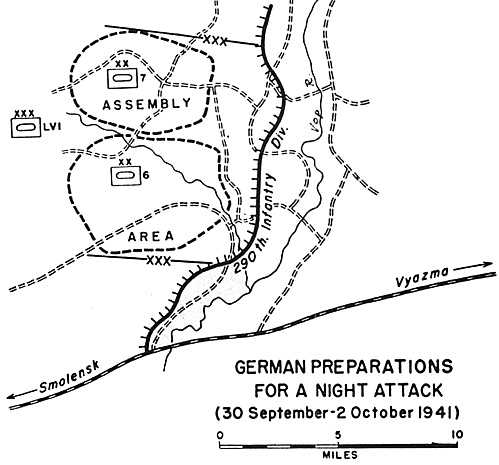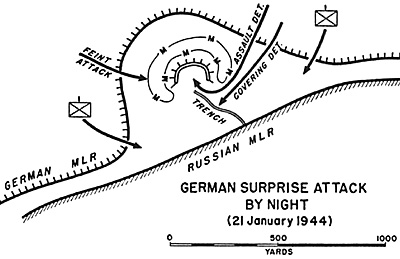 German units carried out night attacks to exploit successes achieved in
daytime, as a prelude to major offensive operations, to restore the situation
where the enemy had achieved a local success, and to camouflage the
execution of other operations, such as a retrograde movement.
German units carried out night attacks to exploit successes achieved in
daytime, as a prelude to major offensive operations, to restore the situation
where the enemy had achieved a local success, and to camouflage the
execution of other operations, such as a retrograde movement.
The starting time for night attacks was set with due regard for the inherent difficulties of fighting in the dark. Action at night was always time consuming; yet, it was usually desirable to conclude any operation before daybreak. The unit commander had to consider these two factors and evaluate his own and the enemy situation before he decided to launch a night attack.
The terrain in Russia was rarely ideal for night attack. In many instances there was good cover for the approach, but the enemy-held territory usually did not afford good visibility, so that the opponent's preparations for defense could not be observed. Whenever there was danger of encountering strong, well- prepared enemy forces, night attacks had to be launched in a direction from which they were not expected.
The success of a night attack depended on careful preparation, proper timing, and selection of favorable terrain. Detailed evaluation of information gathered by air and ground reconnaissance, thorough analysis of captured maps, study of the terrain by the maximum number of officers, road reconnaissance and marking, and provisions for adequate supplies were some of the preparatory measures. Before issuing the operation order the commander discussed his plan in detail and answered questions requiring clarification, so that every officer knew exactly what was expected of him and his men.
These careful preparations applied also to major attacks started before dawn and continued during daylight. Before such operations many nights were required to ready a large body of troops. Attacks scheduled to last but a single night were generally confined to a limited objective not too distant from the starting position. Even these relatively minor operations required thorough preparations to avoid enemy traps or other disagreeable surprises.
The following example shows how carefully LVI Panzer Corps prepared an attack during darkness in the area west of the Dnepr River in September 1941. The objective of the operation was Vyazma, about sixty miles to the east. The situation in the area had been static for several weeks with the 290th Infantry Division holding the front. (Map 4)
For the attack, which started on 2 October, three additional divisions were brought up from other areas-the 6th and 7th Panzer Divisions, and one armored infantry division. Improvement of the poor road net was begun as early as 20 September. Other preparations included the reinforcement of numerous bridges, aerial photography of enemy-held terrain, nuisance raids by a few planes to obscure the noise of traffic on the ground, and maintenance of traffic along the main north-south road to simulate normal supply activity.
On the night of D minus 3 the forward echelons of the two panzer divisions were moved to their assembly areas near the front, so that they could familiarize themselves with local conditions. This also gave the artillery units two days to determine their firing position and data, and to establish observation posts.
The next night the motorized infantry elements of the two panzer divisions were brought up to the area west of the major north-south road, where they detrucked. The vehicles were parked farther to the rear.
During the last night before the attack all assault troops were moved to the jump-off positions, where the forward echelons of their respective units awaited them. The 290th Infantry Division regrouped its forces for the impending attack, while the armored infantry division was held back as corps reserve. At the same time the tanks and empty trucks of the two panzer divisions were moved up to the north-south road.
The operation itself started an hour after dawn and was successf ully completed at H plus 30 hours when a bridgehead was firmly established east of the Dnepr near Cholm. No doubt the carefully camouflaged night preparations of the corps during the preceding weeks were a major factor, for the Russian troops apparently had not anticipated an attack by an entire corps.
 In another instance the Germans launched a night attack on a smaller
scale in the sector southeast of Mogilev in January 1944. (Map 5) Defensive
positions were held by the German 56th Infantry Division, whose front had
been pushed back along a 1,000-yard stretch to a maximum depth of
approximately 500 yards. In the middle of this salient the Russians had
established a strong point that afforded good observation of the German front
and rear area.
In another instance the Germans launched a night attack on a smaller
scale in the sector southeast of Mogilev in January 1944. (Map 5) Defensive
positions were held by the German 56th Infantry Division, whose front had
been pushed back along a 1,000-yard stretch to a maximum depth of
approximately 500 yards. In the middle of this salient the Russians had
established a strong point that afforded good observation of the German front
and rear area.
On 10 January the German commander decided to launch a counterattack to wipe out the Russian salient. Reconnaissance had established that the Russian strong point contained at least one hundred men, equipped with six to eight heavy Machine guns, several heavy mortars, and an antitank gun. In addition, it was known that the Russian position was heavily mined, so that it had to be attacked from the rear, where it was linked to the MLR by a communication trench. It was also realized that the German force had to launch a surprise attack, since the Russian artillery, consisting of at least six batteries, would otherwise break up the attack. The best time for achieving surprises was during the hours of darkness.
The German night attack was to be carried out by an assault detachment composed of one officer and thirty-five men, and equipped with submachine guns and two flame throwers. A covering detachment of similar size was to follow the assault troops, cut the communication trench midway between the strong point and the Russian MLR, and protect the assault detachment against interference from the south. Reinforced infantry companies were to move to both shoulders of the Russian salient, ready to occupy the former German positions after the Russians evacuated. These two companies were to break up the expected Russian counterattack by flanking thrusts. Finally, as a deceptive measure the reinforced German artillery was to deliver intermittent fire on the strong point and on other parts of the Russian front for eight nights prior to the operation.
At 0230, 21 January, the assault detachment started to infiltrate from the flank of the salient, followed by the covering detachment. At 0320 a short artillery concentration was delivered on the strong point, followed by a feint from the west ten minutes later. At 0335 the assault detachment entered the strong point. Simultaneously, the entire German artillery shifted its fire to the southern part of the communication trench. Finally, at 0340 there was an air attack on the Russian division command post.
The operation was so successful that the assault detachment suffered only one casualty; heavier losses were sustained by the covering detachment. The success may be credited to the careful preparation of the assault on the Russian strong point. A relatively small and lightly armed force reached its objective and overwhelmed numerically superior elements because it achieved surprise by night. The Russian counterattack, launched about an hour after the loss of the position, was repulsed by the two German companies' thrusts into the flanks of the Russian attack force.
Back to Night Combat Table of Contents
Back to List of One-Drous Chapters: World War II
Back to List of All One-Drous Chapters
Back to MagWeb Master Magazine List
Magazine articles and contents are copyrighted property of the respective publication. All copyrights, trademarks, and other rights are held by the respective magazines, companies, and/or licensors, with all rights reserved. MagWeb, its contents, and HTML coding are © Copyright 2002 by Coalition Web, Inc. This article appears in MagWeb (Magazine Web) on the Internet World Wide Web.
Other military history articles and gaming articles are available at http://www.magweb.com